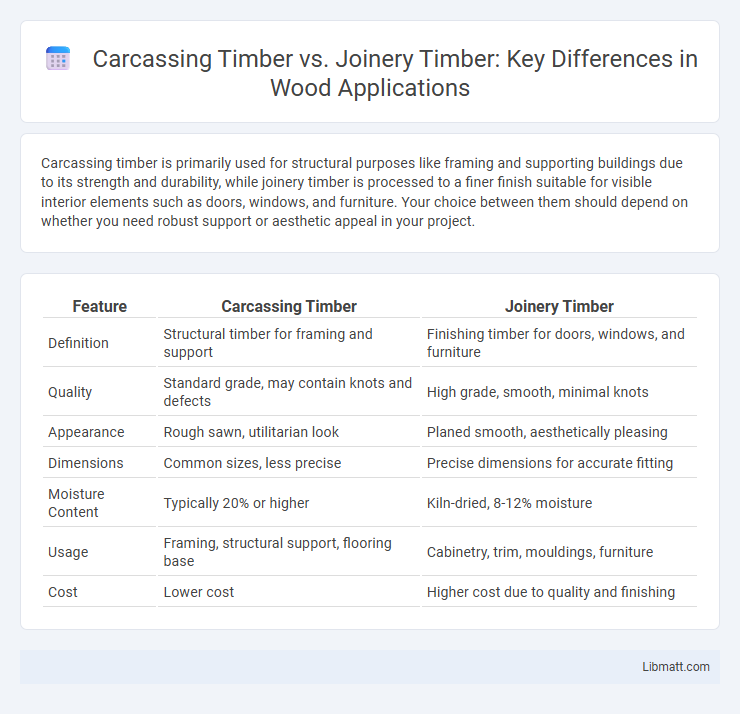Carcassing timber is primarily used for structural purposes like framing and supporting buildings due to its strength and durability, while joinery timber is processed to a finer finish suitable for visible interior elements such as doors, windows, and furniture. Your choice between them should depend on whether you need robust support or aesthetic appeal in your project.
Table of Comparison
| Feature | Carcassing Timber | Joinery Timber |
|---|---|---|
| Definition | Structural timber for framing and support | Finishing timber for doors, windows, and furniture |
| Quality | Standard grade, may contain knots and defects | High grade, smooth, minimal knots |
| Appearance | Rough sawn, utilitarian look | Planed smooth, aesthetically pleasing |
| Dimensions | Common sizes, less precise | Precise dimensions for accurate fitting |
| Moisture Content | Typically 20% or higher | Kiln-dried, 8-12% moisture |
| Usage | Framing, structural support, flooring base | Cabinetry, trim, mouldings, furniture |
| Cost | Lower cost | Higher cost due to quality and finishing |
Introduction to Carcassing Timber and Joinery Timber
Carcassing timber refers to structural wood used in construction for framing, flooring, and roofing, valued for its strength and dimensional stability. Joinery timber, on the other hand, is finer, precision-cut wood used in detailed craftsmanship like doors, windows, and furniture, chosen for its smooth finish and aesthetic quality. Understanding the distinct roles and properties of carcassing and joinery timber is essential for selecting the right material in building and carpentry projects.
Definition and Key Characteristics
Carcassing timber refers to structural wood used primarily for framing and support in construction, characterized by its strength, durability, and often rough-sawn finish. Joinery timber, on the other hand, is high-quality, finely finished wood designed for visible elements like doors, windows, and furniture, emphasizing aesthetic appeal and smooth surfaces. Understanding the difference ensures Your projects use the right timber type for either structural integrity or detailed craftsmanship.
Common Applications of Carcassing Timber
Carcassing timber is commonly used in structural frameworks such as roof trusses, floor joists, and wall studs due to its strength and durability. It is typically selected for load-bearing applications in residential and commercial construction where robustness is essential. This timber type is less concerned with appearance, making it ideal for hidden or internal structural components rather than visible, decorative joinery.
Typical Uses of Joinery Timber
Joinery timber is typically used for interior decorative elements such as window frames, door frames, skirting boards, and furniture making due to its fine finish and dimensional stability. Unlike carcassing timber, which is primarily employed for structural frameworks and rough construction works, joinery timber is chosen for applications requiring precision cutting, aesthetic appeal, and smooth surfaces. Its superior quality and appearance make it ideal for visible components in residential and commercial buildings.
Differences in Grading and Standards
Carcassing timber is graded primarily for structural strength and durability, adhering to standards such as BS 4978 or EN 14081 to ensure suitability for load-bearing applications. Joinery timber, on the other hand, is graded with emphasis on appearance, smoothness, and minimal defects according to standards like BS EN 942 or BS EN 14351-1, targeting aesthetic finishing in interior or exterior woodwork. The differing grading criteria reflect their distinct functional requirements, with carcassing timber prioritizing mechanical properties and joinery timber focusing on visual quality and workability.
Strength and Durability Comparison
Carcassing timber typically offers higher strength and durability due to its use in structural applications, often made from softwoods like pine or spruce that are graded for load-bearing capacity. Joinery timber, usually hardwoods such as oak or mahogany, prioritizes fine grain and appearance over raw strength but still provides sufficient durability for furniture and interior fittings. While carcassing timber excels in supporting heavy loads and resisting environmental stresses, joinery timber balances moderate strength with aesthetic appeal and workability.
Finishing and Appearance Distinctions
Carcassing timber is typically rough-cut and untreated, designed for structural purposes where appearance is secondary, resulting in a coarse finish that requires further processing for aesthetic applications. Joinery timber undergoes precise machining and sanding to achieve a smooth, refined surface ideal for visible elements like doors, windows, and furniture, emphasizing fine grain and consistent texture. You should select joinery timber when the finishing and appearance of your project are paramount, as its quality enhances visual appeal and allows for superior staining or painting.
Cost Factors and Availability
Carcassing timber typically costs less due to its lower-grade qualities and widespread availability, making it ideal for structural frameworks and rough construction. Joinery timber commands higher prices because it requires superior quality, fine finishes, and often hardwood species, which are less abundant and more labor-intensive to prepare. Market demand and regional supply variations heavily influence availability, with carcassing timber being more readily accessible in bulk compared to the selective and limited stocks of joinery timber.
Selecting the Right Timber for Your Project
Carcassing timber is typically used for structural purposes, offering durability and strength essential for framing, while joinery timber is finer, chosen for visible, detailed work such as doors and furniture to provide a smooth finish. Selecting the right timber depends on your project's requirements, including load-bearing needs and aesthetic appeal. Understanding these differences ensures Your construction or woodworking project achieves both stability and visual quality.
Conclusion: Making an Informed Timber Choice
Carcassing timber, chosen for structural support, offers durability and strength essential in construction frameworks, while joinery timber is selected for its fine finish and workability in detailed interior woodwork. Selecting the right timber depends on the project's functional requirements and aesthetic goals, ensuring long-lasting performance and visual appeal. Understanding the specific properties of each type facilitates an informed choice that balances structural integrity with design precision.
Carcassing timber vs joinery timber Infographic

 libmatt.com
libmatt.com